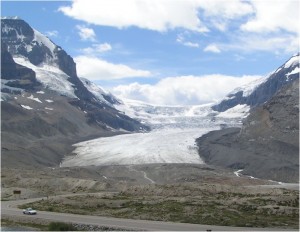 Although overall precipitation levels may not change significantly, we may see an overall reduction in the quantity of water in the province as precipitation patterns change and as the glaciers in the Rockies melt away. This can effect our energy supply as well as water for nature, humans, livestock, and industry.
Although overall precipitation levels may not change significantly, we may see an overall reduction in the quantity of water in the province as precipitation patterns change and as the glaciers in the Rockies melt away. This can effect our energy supply as well as water for nature, humans, livestock, and industry.
On this page we look at these contributors to changes to water quantity:
Click a link in the list above to jump to that topic on this page.
Snow
Winter precipitation plays an important role in topping up lakes and rivers. Most Canadian streams and rivers have an annual maximum flow in the spring from snowmelt. Manitobans are – at times – painfully familiar with this phenomenon. About 25 to 50% of the total annual riverflow occurs as snowpacks melt. (1) With less snow, river and streamflow would experience a net drop, and the wetlands and riparian zones that rely on occasional spring flooding would suffer. (2)
The loss in winter runoff may be offset by increases in springtime precipitation. Manitoba is projected to experience a 20% increase in springtime rainfall. However, problems occur when spring rains fall too quickly, causing floods. Spring runoff is best when it occurs slowly, releasing water into the environment where is may be absorbed by the soil and plants before filling up water bodies.
Ice cover
With less snow and warmer temperatures, water bodies do not build up a solid, thick layer of ice. This can be particularly inconvenient – and dangerous – for northern communities who rely on winter trucking across lakes to bring in supplies. (3)
A thick layer of ice is ecologically important as well. During the spring, ice jams on rivers cause periodic flooding of nearby wetlands, recharging them with water. Without this overflow, wetlands dry out and valuable habitat lost. The Canadian Prairies are the most important region in North America for breeding waterfowl. (4)
Breeding waterfowl populations could drop by 50% in response to reduced precipitation and temperature increases up to 4°C. (5)
Rain
Rains replenish Prairie rivers, wetlands and lakes. However, summer precipitation declines of up to 10% to 20% are forecasted for Manitoba. (6) At the same time, average temperatures are projected to rise, increasing the rate of evaporation from existing water bodies. Droughts may become even more common.
The outlook looks even more serious when considering future water needs. The same conditions that make water supplies scarce also create a greater demand. Crops will need more irrigation. Livestock will need more water to stay cool and hydrated. A growing population will demand access to safe, reliable freshwater.
Acute water problems in the United States and other countries will also threaten Canadian water security.
Glaciers
 Much of the useable freshwater in Western Canada comes from the snow and ice fields of the Rockies. (7) At the mouth of the Saskatchewan River, 87% of the flow is meltwater from the icy peaks of the Rocky Mountains. (8)
Much of the useable freshwater in Western Canada comes from the snow and ice fields of the Rockies. (7) At the mouth of the Saskatchewan River, 87% of the flow is meltwater from the icy peaks of the Rocky Mountains. (8)
Glaciers are receding and thinning as the climate warms. River and stream flows will drop significantly without input from the huge glacial storehouses of freshwater. Already, flows in the major rivers of the western prairies have been reduced to 20-70% of their historic flows. (9)
The Athabasca Glacier (a popular tourist destination in the Rocky Mountains) has receded 1.5 km in the last century.
The Saskatchewan River is a major contributor to the water that flows into the Nelson River. About 90% of Manitoba’s hydroelectricity comes from dams on the Nelson.




